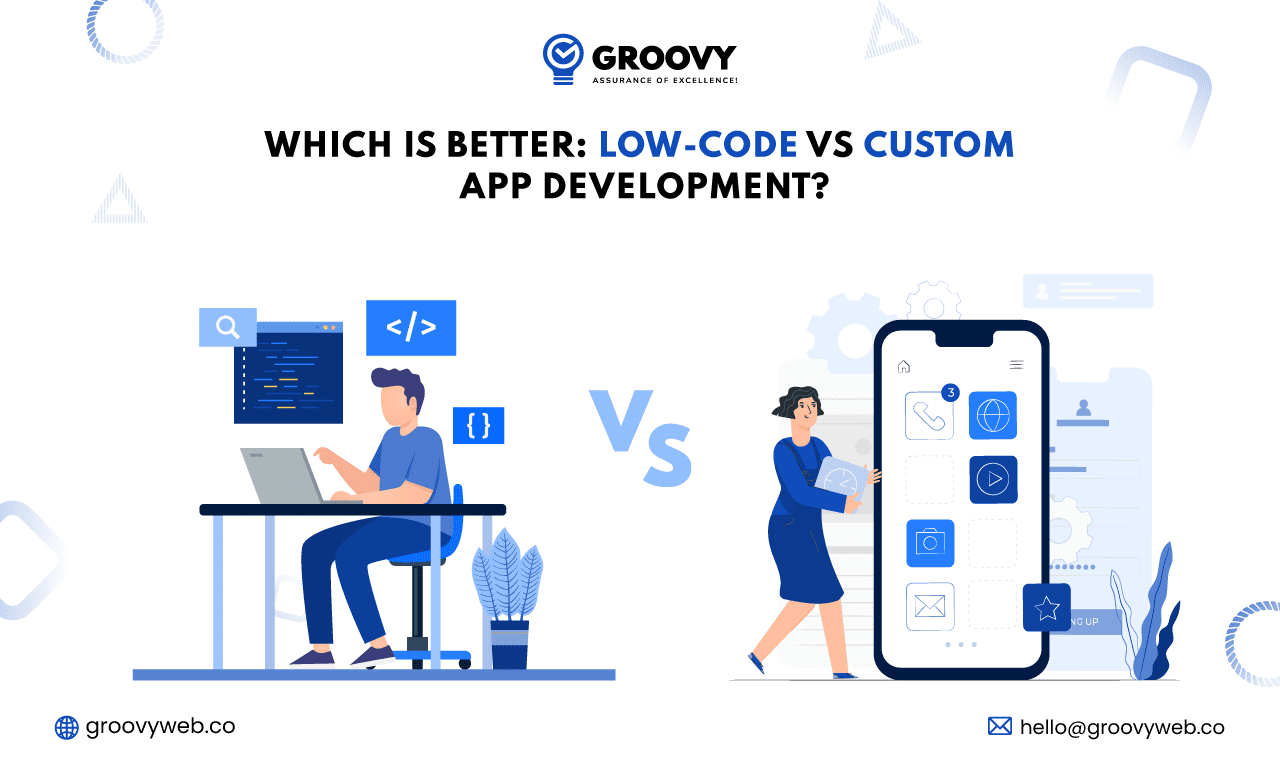Next.js vs React: Which One Should You Choose?
Sagar Patel
December 10, 2024 202 Views
Quick Summary : Next.js and React are two essential tools for building modern web applications. React, a flexible JavaScript library, focuses on creating interactive user interfaces, while Next.js, a React framework, adds features like server-side rendering and static site generation. If you need a simple UI-focused tool, React is ideal. For enhanced SEO, performance, and full-stack capabilities, Next.js is the better choice, making it perfect for more complex projects.
There is a possible confusion between Next.js and React right before a web developer for developing an efficient, scalable, and user-friendly application. Both have gained immense popularity and have different features and other benefits. To get through this extensive comparison will assist you in making a better choice based on your project requirements. React, a JavaScript library developed and maintained by Facebook can build user interfaces, particularly single-page applications. Ever since it was launched in 2013, it has entirely transformed how developers build web applications and architectures, such as component-based, virtual DOM, and declarative methodology, to name a few. If you are considering advanced web solutions, partnering with a Next.js development company can provide significant advantages by leveraging server-side rendering and other Next.js capabilities for your project.
Important Features of React
- Component-Based Architecture: With React, developers can build encapsulated components that care for their state and even compose to create complex UIs.
- Virtual DOM: React uses a virtual DOM to optimize updates. This improves the speed and efficiency through which views are rendered.
- Declarative UI: Developers describe what the UI should look like given a state with React, and React updates the UI when that state changes.
- Huge Community and Ecosystem: React has an enormous ecosystem of libraries and tools and a strong community that provides the greatest support and resources.
Introduction to Next.js
Next.js is an open-source framework developed by Vercel, built atop React for SSR, SSG, and more. Since Next.js was first released in 2016, the framework has widely gained acceptance for improving the performance and SEO of a React application, making it an excellent choice when you want to build a React app with enhanced capabilities.
Key Features of Next.js
- Server-Side Rendering (SSR): Next.js supports the rendering of pages on the server side and improves the load times and SEO.
- Static Site Generation: It can pre-render pages at build time, which makes static pages load faster.
- API Routes: Next.js can make API endpoints within your project, which lowers the complexity of developing a backend.
- Automatic Code Splitting: It splits code automatically to result in smaller bundles with optimized loading performance.
Next.js vs React: Performance
When we compare these two based on performance, Next.js vs React, we first need to consider how each of them manages the rendering and loading process.
React Performance
React uses a lot of client-side rendering, which means the JavaScript gets executed in the browser to generate the HTML. This could lead to highly dynamic and interactive applications but slower load times at the beginning with large applications.
Next.js Performance
Next.js is much faster because it supports server-side rendering and static site generation. In the case of Next.js, the reduction will also be in terms of the amount of JavaScript that the client’s browser has to execute-whereby pages are rendered on the server or static pages that are generated at build time-meaning content pages will load in less time during the first load, particularly making it much more SEO-friendly.
Next.js vs React: SEO
SEO considerations for web applications are essential, especially for content-driven sites and e-commerce platforms.
React SEO
React’s client-side rendering can cause issues in SEO because crawling search engines might fail to index dynamic content that requires the execution of JavaScript. Modern search engines have gone much further in crawling and indexing JavaScript. Still, there can be issues, especially with slower connections or complex applications. Despite these challenges, React remains one of the top JavaScript frameworks, offering a powerful solution for building dynamic user interfaces while keeping SEO considerations in mind.
Next.js SEO
Because of SSR and SSG, Next.js has boosted my experience in SEO. Since Next.js renders pages at the server level or automatically generates static HTML at build time, search crawlers can easily access and index them. The choice between Next.js and React should favor Next.js, especially in applications where SEO is a must.
Next.js vs React: Development Experience
The development experience makes a huge difference when it comes to choosing between Next.js and React.
React Development Experience
React provides flexible and modular applications for creating tools, libraries, and architectural patterns when building an application. It is flexible, an advantage, and a disadvantage. It gives developers the freedom to choose whatever they want, but it requires more decisions and effort to set up.
Next.js Development Experience
A more relaxed approach will be how Next.js can help ease the development process through conventions and features to reduce configuration and decision-making. At this point, with file-based routing, Next.js allows developers to spend more time building the application rather than configuring the environment features like API routes and built-in support for both SSR and SSG.
So, the choice between Next.js or React comes down to the project’s particular requirements and its use case in a situation.
When to Use React
When building highly interactive and dynamic SPAs that rely heavily on client-side rendering, React will work well.
- Flexibility and Customizability: If you want control over the technology stack and architecture, React allows you to choose your tools and libraries.
- Existing Projects: If you already built a project with React, you are better off using React instead of porting it to Next.js.
When to Use Next.js
- SEO Optimization: For applications where SEO stands at the most significant importance, such as content-driven sites, blogs, and e-commerce platforms, the SSR and SSG capabilities of Next.js indeed come in handy.
- Performance: Its features of server-side rendering and static site generation are very suitable for applications with high-performance demands and those requiring minimal load times.
- Full-Stack Development: Built-in API routes in Next.js make full-stack application development much less arduous in managing frontend and backend-side applications in one.
- Simplified Development: Conventions and built-in features of Next.js make it the best choice for developers who need minimal configuration and decision-making, which is perfect for the streamlined development experience.
Next.js vs React: Community and Ecosystem
The community and ecosystem of both Next.js and React are strong but will be discussed below:
React Community and Ecosystem
- Compared to Next.js, React has been around for much longer and has a larger community and ecosystem. Several libraries, tools, and other resources, such as popular state management libraries like Redux, MobX, and Context API, are available for React developers.
- Next.js is a relatively younger cousin of React but has rapidly gained an impressive following and a rich, complete ecosystem. The Vercel company works at maintaining and supporting the framework and provides wonderful, comprehensive documentation, examples, and integrations.
Next.js vs React: Learning Curve
The learning curve is always a critical concern, mainly for new developers or teams changing to a new technology.
Learning Curve for React
One of the reasons for React’s steep learning curve, particularly for starters, would be the concept of JSX, components, state management, and the virtual DOM. Once understood, developers can take full advantage of the flexibility and power that React has to offer when building complex applications.
Next.js Learning Curve
Since Next.js builds on top of React, a developer has first to know the basics of React to penetrate Next.js. At the same time, though, Next.js simplifies much more in development by conventions and built-in features that may reduce the overall learning curve.
Next.js vs React: Pros and Cons
In summary, let’s list the pros and cons of Next.js vs React.
Pros:
- Extremely Flexible and Modular: React is very flexible in building a UI. The component-based architecture enables developers to create reusable UI components that can be composed to form complex applications.
- Huge and Severely Active Community: React boasts an enormous, severely active community of developers, which is one of the biggest strengths of the library. It continuously adds value to the React ecosystem by developing libraries, tools, and frameworks that extend React’s capabilities.
- Huge Ecosystem of Libraries and Tools: The React world has many third-party libraries and tools that make development easier and better. Popular libraries like Redux for state management, React Router for navigation, or Jest for testing are used and supported by nearly everyone.
- Best suited for Dynamic and Interactive SPAs: Another reason React is best suited for SPAs is client-side rendering. A SPA is highly dynamic and very interactive regarding user experience. The UI updates in this application would become fast and smooth due to the virtual DOM and efficient diffing algorithm in place.
Cons:
- Requires Much More Configuration and Setup: Flexibility of React comes at the price of sometimes requiring considerable configuration and setup. Much of the routing, state management, build tools, and, more often, must be decided by developers within the general development stack.
- SEO and Client-Side Rendering: Issues Laced with Default React Client-Side Rendering This means that having to contend with client-side rendering, SEO could be one more challenge. As it renders the content on the browser and not on the server, search engine crawlers may need clarification about how to index the content and may, therefore, hurt a website’s search visibility.
- Potentially Slower Initial Load Times: React applications would have slower initial load times, most noticeably for massive applications. The JavaScript bundle must be downloaded, parsed, and executed before rendering the content.
Pros and Cons of Next.js
Pros:
- Excellent Performance with SSR and SSG: Regarding performance, Next.js scores well because it supports server-side rendering and static site generation. The former will render pages on the server to deliver fully rendered HTML to the client, significantly improving load times and perceived application performance.
- SEO Optimization: Another advantage of Next.js is that it can enhance SEO. This is achieved because search engine crawlers can send the application pages to the server for rendering, or statically generated pages can be quickly crawled and indexed.
- Streamlined Development: With integrated Capabilities, Next.js offers a default set of pre-built capabilities and conventions that can streamline development. Capabilities that include file-based routing, API routes, and automatic code splitting help cut the boilerplate setup amount of work the developer has to devote to navigating a development environment rather than creating an application.
- Full-stack development: capabilities with routes for API: Next.js has made it easier to implement full-stack development, allowing users to develop the API endpoints within the same project. It saves the user from having to maintain two separate systems: one for a frontend and another for the backend server; this helps reduce the complexity and increase a developer’s productivity.
- Automatic code splitting: to optimize loads, Next.js splits the code into smaller bundles according to the pages and components of usage. Only the required JavaScript is loaded for every page, thus optimizing the performance while loading and reducing the total bundle size.
Cons:
- Needs a Good Understanding of React and Next.js: One needs to have a good knowledge of React and Next.js to derive maximum benefit from Next.js functionality. That makes it difficult for novices who would have known neither technology.
- Less Versatility Than React in Isolation: While Next.js comes pre-reckoned with many built-in features and conventions, it may also limit versatility in some aspects. The developer has to play within the Next.js way of doing things and, hence, has no choice but to do so, which sometimes may not align with the tools or architectural patterns they would prefer.
- Smaller Community and Ecosystem Compared to React: Even with its strong and growing community, Next.js is still much smaller than the React ecosystem. Consequently, there are fewer third-party libraries and tools designed especially for Next.js.
Next.js vs React: Examples
Real-life examples make the use cases of Next.js vs React clear.
React in Practice
- Facebook: Since Facebook is a creator of React, it uses it quite heavily in building and running many of its applications on the web, which are highly dynamic and interactive for the users.
- Instagram: As an offering from Facebook, Instagram employs React while developing fast and responsive interfaces on the web.
Airbnb uses React to provide users with a smooth, interactive experience on their booking application.
Next.js in Action
- Vercel: Vercel is the company behind Next.js, which is used on its website as an example of speed and SEO-friendliness in page generation.
- Hulu uses Next.js to deliver its performant and SEO-optimized media stream.
- Twitch uses Next.js to develop its fast, responsive video streaming interface, using SSR and SSG.
This, therefore, means that there is no one-size-fits-all. It will depend on your specific needs and wishes for the project, goals, and more. With React, you can think out of the box and get maximum freedom; React has a vast ecosystem of libraries and ways to achieve specific things. Lastly, with Next.js, you will get better performance, better SEO, and a more streamlined development process.
Next.js vs.React
Here are some best practices to guide you to the next project: Next.js vs.React
-
Requirements for SEO
If your application needs to be SEO aware, Next.js is now in the lead line since it offers server-side rendering and static capabilities.
-
Site generation.
Still, there are more performance requirements to be met. Its SSR and SSG features weigh highly in applications that require a quick initial load time and optimized performance.
-
Development Preference:
If you want an easy development process with many inbuilt features and conventions, you can go with Next.js. However, use React if you want the complete freedom to customize every aspect of your application at will.
-
Type of Project:
React will do this if the application is an interactive single-page web application where only the client side has to be rendered. However, for a content-heavy web application like an e-commerce site, the SEO and performance benefits of Next.js shine through, making it a preferred choice for the best SEO marketers who prioritize visibility and speed.
-
Learning Curve and Team Expertise:
If your team knows React, switching to Next.js would be smooth and lucrative for you. On the other hand, if it’s an entirely new team with novice developers, then using React as the base would better prepare them to use Next.js.
Integrating Next.js vs React
One of the great strengths of Next.js vs React is that they are not mutually exclusive. Next.js is built on React, so you can start with a React application and migrate to Next.js as your project evolves. This flexibility allows you to leverage the strengths of both tools without committing to one over the other from the outset.
Future of Next.js vs React
Next.js and React are continuously improving and developing, with the latest features being introduced regularly. React 18 brought new functions for concurrent rendering and server components, enhancing performance and flexibility. Meanwhile, Next.js continues to elevate the developer experience with its performance optimizations, solidifying its position as one of the most impressive server-side rendering and static site generation frameworks. With such advancements, businesses often wonder about the cost of hiring react developers to leverage these cutting-edge technologies effectively.
Written by: Sagar Patel
Sagar Patel is the CTO and Co-founder of Groovy Web. He was involved in the telecommunications & Automation industry during his early career. Still, due to his attitude toward learning anything new and mastering it, he now works as a CTO for Groovy Web. Through their business mindset and logical approach, they have taken their company to the next level; His responsibilities now include all aspects of the business. Among them are finance, process design, and development.
Frequently Asked Questions
We hope these clear your doubts, but if you still have any questions, then feel free to write us on hello@groovyweb.coWhen should I choose Next.js over React?
Next.js is a great choice if you need server-side rendering or SEO optimization or want to build static websites with faster loading times. It also simplifies development with features like automatic routing and API handling. React is better if you prefer more flexibility and customize your setup.
Is learning React necessary before using Next.js?
Yes, learning React is essential before using Next.js. Since Next.js is based on React, understanding React concepts like components, hooks, and state management is critical to effectively using Next.js.
Which is better for SEO: Next.js or React?
Next.js is better for SEO because it supports server-side rendering and static site generation, which allows search engines to index your content easily. React by itself does not offer these capabilities without additional configuration.
Is Next.js more scalable than React?
Next.js can be more scalable than React for specific projects, particularly those needing built-in SSR or static site generation. However, Next.js and React can be scaled effectively, depending on the architecture and tools you use for the backend and deployment.
Related Blog

Rahul Motwani
How Much Does It Cost to Put an App on the App Store
Mobile App Development 14 Nov 2024 15 min read
Ashok Sachdev
Why Businesses Prefer Next.js Development Companies for Measurable Web Application
Web App Development 18 Dec 2024 11 min read
Rahul Motwani
Which is Better: Low-Code vs Custom App Development?
Mobile App Development 13 Nov 2024 14 min readSign up for the free Newsletter
For exclusive strategies not found on the blog